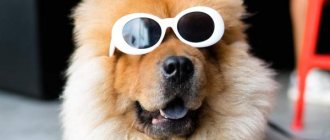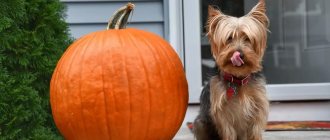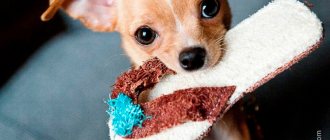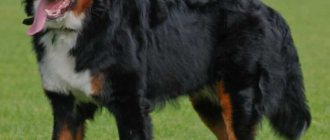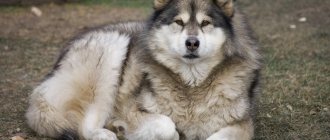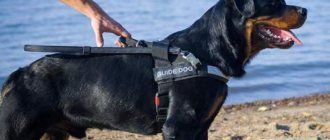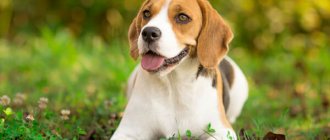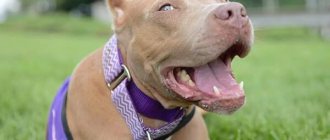Hunting breeds in general are considered one of the most savvy and intelligent of all, so they can be found both in circus shows and on duty in rescue squads, in the police, and at customs.
In the article I talked about 24 breeds of dogs for hunting, with photographs and a short description of the character traits and behavior characteristic of the breed.
There are several varieties:
- Hounds (beagle, basset hound, bloodhound) - track prey (hares, foxes, wild boars) by smell, chase it barking until the hunter or drive it into a dead end. They have a sensitive sense of smell, endurance, and perseverance.
- Greyhounds (Afghan, Russian, Persian) are hunting dogs for baiting animals. They freeze in a stance when they detect game, and develop enormous speed when pursuing it. Having caught up with the prey (hares, foxes, small ungulates), they strangle it. They often have a weak sense of smell, but keen eyesight. Greyhounds are used more often in large open areas - in the steppe and forest-steppe, and less often - in forests.
- Burrowers (dachshund, fox terrier) are small dogs for hunting, capable of entering narrow burrows when searching for or chasing prey (badgers, foxes, sometimes hares and black grouse). Mobile, nimble, they drive or drag the animal to its owner.
- Pointers (Irish Setter, Golden Retriever) - used in bird hunting with a gun. They freeze in a stance when they spot prey to show the hunter the direction of the shot, or they lift the bird into the air.
- Laikas (Russian-European, West Siberian) - track small game and large animals. Universal huskies hunt ducks and wood grouse, as well as wild boars, moose, and bears. They catch up with large prey and hold it until the owner arrives with bites and barks, and the birds are lifted into the air under a shot and their carcasses are brought to the owner.
Many hunting dogs have their tails docked after birth, which otherwise quickly become damaged during the chase. In recent years, world canine communities have recommended docking the tails of only those animals that are actually used for hunting, and leaving their full length to companion pets.
Which breed do you prefer?
Cynologists count more than a hundred types of hunting dogs, and use about two dozen directly for hunting. These include huskies, pointers, hounds, and greyhounds. The choice of breed is made based on how you will hunt and what conditions you can provide. Experts do not advise choosing a universal breed; it is better to prefer a narrow specialization.
The hunter's living and working conditions matter. For example, if he lives in the city and hunts during his vacation in early autumn, then it is better to choose a pointer. For rural residents engaged in harvesting work in the fall, it is better to prefer a hound or greyhound dog and go hunting in late autumn or early winter. If you hunt systematically, then get a husky or a burrowing dog, for example, a dachshund or fox terrier. These dogs are good at working in game-rich areas.
Greyhounds
Afghan Hound
The Afghan Hound is a beautiful hunting dog originally from Afghanistan, an unspoken symbol of the country. Greyhounds were involved in hunting a variety of animals, from hares to wolves. In parallel with hunting, they coped with the protection of homes and livestock, and served as bodyguards for important persons. Despite their apparent fragility, gracefulness and delicacy, Afghan hounds are hardy, have good health, they develop enormous speed in pursuit (up to 50 km/h), and can jump high and far. They have strong jaws for holding prey and the necessary passion for pursuing it. The pride of the breed is its thick, long, silky coat; it requires daily attention from its owners. The character is not easy; when living in the city and in a family, you need to make efforts to properly raise an Afghan. Long runs and long walks are essential for your pet's well-being.
Russian greyhound
The Russian Greyhound is an elegant, large animal that can reach speeds of up to 90 km/h when chasing (over short distances). In a jump, it covers a distance of up to 3 m. Greyhounds have been popular in Russia since the 17th century, when every landowner kept a pack of hunting dogs. Russian greyhounds have sharp eyesight, lightning-fast reactions, viciousness towards driven game, but a weak sense of smell. All qualities of the breed are focused specifically on high-speed hunting: if used for other purposes (protection, search), then disappointment will quickly set in for both the owner and the pet. Each individual has a pronounced individuality, a subtle psyche, pride, and strives for independence. Appreciates the good attitude of the owner “on an equal footing”, does not know how to curry favor, and cannot tolerate aggression. It can remain in a calm state for a long time, but instantly changes when the situation changes.
Persian Greyhound (Saluki)
The Saluki is a greyhound that originated from the Bedouin Arab tribes. Nomadic tribes bred greyhounds so that they could hunt gazelles, foxes, rabbits, and hares during the movement of the caravan. Salukis, like horses, were considered family members by nomads. The appearance of these pets is elegant and graceful, but behind this sophisticated appearance lies endurance, strength, speed of up to 70 km/h, and agility. Salukis are able to chase prey for several hours and then hold it until the owner arrives. It is impossible to suppress their hunting instinct; it is laid down at the genetic level. In the family, Persian greyhounds are affectionate, obedient, silent, balanced, and clean. They have keen hearing, so they are sometimes used as watchmen (they give a voice when strangers appear). Need long walks and jogging.
Greyhound
Greyhounds are greyhounds originally from Great Britain. They were bred to hunt hares; here, in a short chase, greyhounds can reach speeds of up to 67 km/h. The appearance is unusual due to the small head with high stature and massive chest. Various colors are allowed, although initially the predominant color was gray (Greyhound in English - gray greyhound). They are considered one of the smartest dogs. They are easy to train and adapt to their owner. They know how to navigate space and make decisions quickly. They do not need long walks or regular physical activity, so they easily take root in apartments or in families with busy owners. When walking, they tend to run away when they see a “target.”
Italian Greyhound
The Italian Greyhound or Small Italian Greyhound is a miniature Greyhound bred in Italy. Italian greyhounds lived in the houses of wealthy citizens and in royal palaces. They hunt hares and small rodents - mini greyhounds are swift in their movements, very mobile, have keen vision, and are well oriented in space. Disadvantages: weak sense of smell, restlessness in transport, excessive noise in the apartment (barking, growling at extraneous sounds), physical fragility. When kept as a companion, the innate instinct of pursuit also becomes a problem, because pets can suddenly chase after a cat, squirrel, mouse or rustling package. The family members are friendly, tactful, and play enthusiastically with children. Today, small greyhounds are used primarily as companions.
Dog booth
The hunting dog is kept in a dry and bright booth. An alternative could be a shed. The room or booth should not be hot in summer or cold in winter; there must be protection from precipitation. Drafts are not allowed. Place the booth on the sunny side, but provide a canopy as protection from the sun. You can put it in an enclosure welded from iron rods.
Straw is placed on the floor of the booth, changing it 1-2 times a week. In winter, more straw is needed to keep the dog warm. Every two weeks, disinfect the walls, wash them with a solution of creolin in hot water. The excrement is buried or thrown into the sewer.
You need to get used to the booth from a young age. All attempts to leave the “house” are strictly suppressed. The dog should not howl or whine. It will be easier for him to endure separation from his owner if you devote enough time to the pet and give him more freedom of movement. Then the booth will become a comfortable place to relax.
Hunting dogs are not kept on a chain, unless there is no other way to keep the dog. Place it on a long and light chain, which should have a carabiner on it. The dog should not get confused in it.
Contents in the apartment
Small hunting dogs can be kept in an apartment. Give your dog a place away from heaters with an easy-to-clean rug, mattress and pillowcase, or tarpaulin-covered wooden frame. Teach your pet to its place, prohibiting it from sitting on upholstered furniture. His place will be an area for a relaxing holiday.
Find a place for food and water bowls. Water must be available at all times; food must be served only during meals. Ventilate the room where the dog lives more often, and do not allow him to stay in the bathroom or kitchen for a long time.
A hunting dog living in an apartment with its owners will become smarter and more sociable. To prevent your pet from spoiling things while the owners are not at home, you can buy a crate where you can place the dog while you are away. When living in a city apartment, the need for several daily walks becomes even more urgent.
Feeding
Hunting dogs have increased stress, so their diet must be balanced, and their food must be high in calories to cover energy costs. But you can’t overfeed the dog either. Feed twice a day in not too large portions. Provide constant access to fresh water. Dehydration is very dangerous.
What not to do:
- treat treats at the dog’s request - only as a reward;
- give food with spices so as not to harm the sense of smell;
- feed between meals.
A hunting breed dog is fed 1-2 hours before the hunt - a hungry dog is not allowed to hunt. The food must have time to be digested. After the hunt, let your pet rest and only then feed it. A tired dog does not have a good appetite. If you spend the whole day hunting, then give food little by little every 2-3 hours.
During the hunting season, the dog must receive more high-calorie food due to increasing stress. The energy value of the feed increases by 10%. Switch to this diet 1-2 weeks before the start of the season.
Hygiene
Long-haired hunting dogs require daily grooming. Purchase a comb and brush for this procedure. Combing begins from the head, moving towards the tail, processing every centimeter of fur. If it is very tangled, untangle it by hand. If it doesn't work, cut it off. Combing is also useful for cleansing the hair – removing dust and dirt.
Hunting dogs are bathed once a week with dog shampoo or soap. Bath procedures can be done more often if necessary. In summer they often bathe outdoors, in winter indoors. In the warm season, the dog will be happy to swim in the pond. At the end of the procedure, pat the fur dry with a towel.
Particular attention is paid to the dog's ears. They are carefully cleaned with cotton swabs dipped in hydrogen peroxide.
Coping breeds
Irish Setter
The Irish Red Setter is a hunter of forest, steppe and swamp game. Color - from light red to chestnut with a red tint. Physically tough, fast, but not very strong and muscular. The Irish Setter has a complex character. He is energetic, temperamental, loves to run and play, so he is not suitable for busy, peace-loving people. Learning requires consistency and persistence. A properly raised pet becomes an ideal companion: gentle, friendly, kind, patient, affectionate and obedient. There is no aggression; the setter even greets strangers with indifference or a wagging tail. Open spaces are welcome for walks: forest, park, field.
Golden Retriever
The Golden Retriever, or golden retriever, is a hunting dog from Great Britain. Coat color is all shades of cream and gold. The retriever was bred as a land and waterfowl hunter, but today the scope of application has expanded. Golden retrievers serve as nannies, rescuers, trackers, and bloodhounds. Their work as guides and in the therapy of children with mental disorders is especially valued. They make excellent companions for both young families with children and single people with disabilities. Golden retrievers are kind, affectionate, smart, and neat. Depending on the circumstances, they can be calm or playful. They learn quickly, follow commands with pleasure, and accompany their owner in any activities. They love to swim.
Labrador Retriever
The Labrador Retriever was bred in Canada as a hunting gun dog. Labradors brought small game from the forest, and also helped hunters pull out nets by diving into the water after them. Today, in addition to their original purpose, they serve as a rescuer, guide, and companion. An excellent choice of breed for a family with children, Labradors take unspoken patronage over them, becoming their nanny, friend, assistant. Retrievers are very mobile, active, obedient, affectionate, have high intelligence, and easily adapt to their owner’s mood. We are ready to participate in any activities, be it fishing, hunting, hiking, exhibitions, competitions or communicating with children as part of correctional programs.
Russian hunting spaniel
The Russian hunting spaniel is the only gun dog bred on the territory of the former USSR; the standard was registered in 1951. The popularity of the breed was promoted by the writers V. Bianki and M. Prishvin, who kept several spaniels. The Russian Spaniel swims and dives well, has excellent sense of smell, is strong, hardy, and persistent. Used for hunting hares, field birds and waterfowl. In the family - calm and obedient, willingly tinkering with children. Needs physical activity and long walks. Grooming is simple; special attention should be paid to combing the abundant hair on the paws, otherwise tangles will form.
American Cocker Spaniel
The American Cocker Spaniel is a small game bloodhound, a cross between the English Cocker Spaniel and the American Spaniel. The breed specializes in chasing birds, this is reflected in its name - “cocker” is translated as “woodcock, sandpiper,” but they are no worse at catching rabbits. Spaniels are active, agile, curious, affectionate and loyal. They are excellent at training, get along well with children, have aristocratic manners and self-esteem. They differ from English cockers by their large eyes, short muzzle and thick, long hair. It is wool that gives owners daily troubles: combing, cutting, trimming, especially for show animals.
Walking features
Dogs of hunting breeds love freedom very much; to maintain shape and good mood, they need to move a lot and constantly. This way the dog will release the accumulated energy.
During walks, engage in training, mastering simple commands that will help the dog perform its duties while hunting. Puppies need to be trained starting at 7 months of age. In addition to the basic commands that every dog should know, a hunting dog learns the commands “carry”, “take”, “give”, “search”.
Recommendations for walking:
- walk at the same time three times a day;
- The duration of the walk is at least half an hour;
- The dog must walk on a leash and muzzle.
To adapt to the outside world, it is useful to take your pet out of town, into the forest or into the field. There the dog will get maximum movement, and the absence of people will allow him to run freely. Take your dog out into the countryside once he has become comfortable in urban environments.
Burrow breeds
Dachshund
The Dachshund is a burrowing breed of dog with very short legs. Depending on the size, there are standard, miniature and rabbit varieties. In their homeland, Germany, they used dachshunds to hunt badgers and other burrowing animals. The short-legged “hunters” entered holes without obstacles, drove the prey to the owner, and, moreover, did not require large expenses for maintenance. Dachshunds have a hunting instinct, intelligence and fearlessness, endurance and excellent sense of smell. They are energetic, reliable, smart and loyal, always full of optimism, and rarely sit idle. In our country, dachshunds are bred as ornamental animals. They adapt quickly to the family. Due to their short legs, in order to avoid back injuries, they should not jump from heights, run at speed, or stand on their hind legs.
Jack Russell Terrier
The Jack Russell Terrier originated in England and is now widespread in Australia. Selection work with terriers to develop a new breed was carried out by the priest Jack Russell, in whose honor they gave it the name. Used as a rat catcher and burrow hunter mainly for foxes and badgers, as well as hares, birds and water rats. The Jack Russell Terrier is a small hunter, but very brave, obedient, and hardy. Maintenance in an apartment is made difficult only by the pet’s irrepressible energy, when cute pranks develop into canine tyranny. It is necessary to properly raise your pet from the first days in order to avoid chewed furniture and shoes, damaged sofas and torn pillows. A hyperactive animal requires long active walks, physical and mental stress, and participation in competitions, for example, in mini-agility, is encouraged. The tailed “motor” becomes an indispensable partner in all outdoor games, especially with children.
Fox terrier
The Fox Terrier is a breed of hunting dog bred in Great Britain. Fox Terriers were used for burrow hunting of foxes and other game. Despite their rather average size, fox terriers have physical strength, recklessness and fearlessness in hunting, and obedience. Hunting instincts are pronounced; when living in urban environments, they chase cats and other small animals, forgetting about the owner and not hearing his commands. The pet is cheerful, smart, independent, and does not know fatigue. Always strives for movement, therefore it is suitable only for active people who love hunting or sports - for them the Fox Terrier will be a faithful companion and partner. In a confined space, for example, left in an empty apartment for a long time, the fox terrier becomes destructive and barks loudly, irritating the neighbors.
Jagdterrier
The Jagdterrier is a medium-sized German burrowing dog. The breed was created in the 20s of the 20th century by mixing a fox terrier and a black and tan terrier specifically for hunting. As a result, real “German devils” appeared - independent, wary of strangers, angry and merciless in their prey. The passion for pursuit, the excitement of the chase is inherent in them at the genetic level. They often independently take on the role of guardian of the home and family. When kept at home, they need long walks and physical activity. German Jagdterriers do not like babysitting; they are tolerant of children, but without enthusiasm.
Airedale
The Airedale Terrier is a hunting breed bred in England to hunt ducks, river rats, poultry, hares, rabbits, raccoons, wolves and deer. During military operations, Airedales served as signalmen, rescuers, demolitionists, and assistants to medical teams. Today, Airedale Terriers work in the police and rescue services. Erdeli are friendly, absolutely devoid of aggression towards people, energetic, temperamental, and sociable. They are confident, brave, smart, and sometimes stubborn. They train quickly, do not get into fights, but if necessary, they protect the owner. They love to swim, run through fields and forests, and play with children.
